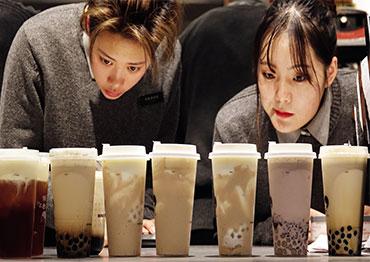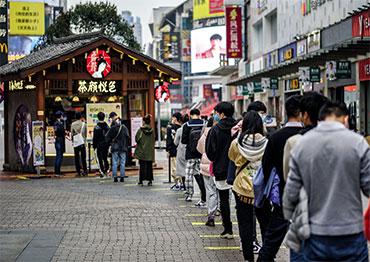Milk tea brand Chayan Yuese, which translates to Modern China Tea Shop, made headlines in December when extraordinarily long lines formed outside its new outlet in Wuhan, Hubei Province. Anticipating a crowd, the brand, based in Changsha, Hunan Province, chose to have its grand opening mid-week. Still, some waited eight hours before reaching the counter.
This is not the first time a milk tea shop grabbed media attention. In recent years, this new spin on traditional milk tea, made fresh with quality tea leaves, fruits, milk and other natural ingredients, has become trendy, especially among young consumers. Some aficionados travel hundreds of kilometers to taste a local variation of milk tea.
Behind the trend is a growing market bolstered by players and investors. A December 2020 report by research company CBNData put the number of milk tea drinkers in the Chinese mainland at more than 340 million, up from 152 million in 2017. Nearly 70 percent were born in the 1990s. The market for tea-based drinks is expected to exceed 100 billion yuan (US$15.5b) by the end of 2020, more than twice the 44.2 billion yuan (US$6.8b) of 2017. In 2020, investment in tea drinks exceeded 4 billion yuan (US$618m), while the market values of Hey Tea and Nayuki, major brands in the process of getting listed, are expected to surpass 10 billion yuan (US$1.5b), according to CBNData.
Xuanzi, a college student from Dezhou, Shandong Province, estimates she drank more than 200 milk tea drinks in 2020 alone, costing her at least 3,000 yuan (US$464) – a large sum for a student. Xuanzi posts annual photo collages of all the teas she drinks each year on social media app WeChat. She says milk tea is an easy and affordable way to treat herself.
Lin Youcai, a 22-year-old woman from Fuzhou, Fujian Province, describes milk tea as the “sweetener” in her life. “Regardless of health concerns, I feel like I own the whole world when I enjoy a cup of sweet milk tea,” Lin said. She started a chat group on arts and culture site Douban in 2018 dedicated to all things milk tea. The group now boasts over 66,000 members.
For many young people, sweet milk tea is more than a beverage. Lin said drinking it helps her unwind. When she was preparing to sit her accountancy certification in 2020, she relaxed with her favorite milk tea. Shan Weijun, founder of Shanghai tea brand Auntea Jenny, said that many commented on their WeChat posts that a milk tea after a hard day brings them joy. He said they like milk tea because it gives them the feeling of “being happy and satisfied” without spending too much.
Unlike traditional Chinese tea, the portability of milk tea makes it a fashionable accessory. It is common to see young people holding a cup of milk tea when they hang out with friends or in photos posted to social media. Young office workers regularly place group orders for delivery. For some, it is a way to break the ice or treat someone.
What started as a beverage popular with women and students has found greater appeal. Peng Xin, founder of Nayuki, said at a recent industry conference that Nayuki’s male customer base increased by 20 percent over the past five years.
Tea drinks with fresh ingredients follow China’s upgrading consumption trends, replacing powder-based milk teas as a mainstream product for young consumers, Lai Yang, president of a research institute under the Beijing Municipal Commerce Bureau told Sina’s financial news platform Senrencaijing. “Milk tea caters to the trend for high-quality products and satisfies young people’s social and psychological needs. It brings made-to-order tea drinks to a higher market level with great prospects,” Lai said.
First appearing in Taiwan, milk tea arrived on the Chinese mainland in the late 1990s. Served with tapioca balls (also known as bubble tea), milk tea was sold in small shops near schools. In 2000, Hong Kong’s RBT Tea opened its first store in Shanghai. Several years later, powdered milk tea brands like Xiangpiaopiao and Youlemei became household names. Between 2006 and 2011, Taiwanese tea brands such as Coco and Yidiandian entered the market. With low prices to target young consumers, the brands quickly reached smaller cities and shops sprang up around colleges and high schools.
However, the industry reshuffled amid complaints of subpar ingredients and food safety concerns. Sensing opportunity, brands boasting quality ingredients such as Hey Tea, Chayan Yuese and Nayuki emerged between 2012 and 2015. E-commerce and delivery apps accelerated their popularity. Lesser quality ingredients such as powdered tea mix were replaced with fresh ones such as fruits, grains and cream to meet consumer demand.
The milk tea market is divided between instant tea powder, bottled or canned milk tea, and made-to-order teas. According to Forward Intelligence, a market research supplier, the instant powder and bottled tea markets are saturated.
The market for fresh milk tea, however, is still expanding. On June 22, 2020, Mixue Bingcheng, a tea franchise targeting the midto low-end market in smaller cities, became the first Chinese milk tea company to open more than 10,000 outlets. High-end brands are also expanding, though at a more moderate rate. Shenzhenbased Hey Tea, for example, had opened 695 stores globally by the end of 2020, more than 300 in 2020 alone, according to its annual company report released in February 2021. The number of retail outlets for Nayuki, founded in 2015 in Shenzhen, rose to 507 that month, up from 155 at the end of 2018. The company filed for a Hong Kong IPO in early February.
The market for fresh tea drinks was 60 billion yuan (US$9.3b) in 2019, with a CAGR (compound annual growth rate) of 29.4 percent between 2015 and 2019, according to an analysis from Northeast Securities in December, which predicts the market scale to reach 172.2 billion yuan (US$26.6b) by 2024.
Capital is flooding the market. Tea Buds, a brand established in 2019, said in December that it received millions of yuan in financing. A month earlier, Auntea Jenny announced it secured 100 million yuan (US$15.5m). CBNData’s December report shows that in 2020 alone over 4 billion yuan (US$618m) was injected into the market.
Despite the growth, market players are struggling to make a profit. CBNData’s report shows a total of 480,000 milk tea outlets in China. According to a 2018 report from IiMedia, an industrial data provider, just 18.8 percent of milk tea outlets stayed in business for longer than one year. Nayuki was in the red for two years before Q3 2020, according to its prospectus.
While taste is important, brands, particularly those expanding rapidly, are challenged to ensure the quality and innovation of their product lines. Brands that fail to adapt to changing customer demand are abandoned. Many brands are not distinct or unique. Most offer menus of fruit teas, milk teas and cream-topped teas that are easy to replicate. For brands such as Chayan Yuese, Modern China Tea Shop and Hey Tea, copycats are a cause for concern.
Meanwhile, the industry is plagued with food safety concerns, sanitation issues and excessive marketing. In July 2019, brand Ganchadu was accused of using rotten fruit and selling day-old teas.
In February, Chayan Yuese came under fire for a sexist ad campaign. Some brands reportedly hired people to line up outside their stores.
“The milk tea market is experiencing fierce competition. Only 20 percent of stores are making money, and only a few earn big,” a former milk tea shop operator in Fangchenggang, Guangxi Zhuang Autonomous Region told NewsChina. He sold the shop after failing to turn a profit.
Analysts are still bullish about the market, especially for high-end brands. According to a February report from Guosen Securities, the domestic made-to-order milk tea market could eventually resemble that for coffee in the US and UK in terms of culture and consumer base.
Most brands are working to develop a café-like culture around milk tea, where shops are places to work and socialize. Peng Xin, who aims to build Nayuki into a popular hangout like Starbucks, said that milk tea brands are seeking to attract young consumers with innovative products and foster a lifestyle around milk tea.
But that remains to be seen, analysts said. Milk tea is popular mainly among young people and does not have the same wide appeal as coffee. While milk tea makes for attractive social media posts, coffee houses remain the first choice for gatherings like work meetings and study sessions.
“The consumption power of the target market for milk tea is not as strong as that for coffee, which means it is harder for milk tea to raise capital to grow from a commodity to a culture,” Chang Jiang, an associate professor and specialist in consumption culture at Tsinghua University, told NewsChina.
“On the other hand, to become a culture, milk tea requires a better story, which means more work needs to be done in exploring its cultural significance.”

 Old Version
Old Version
